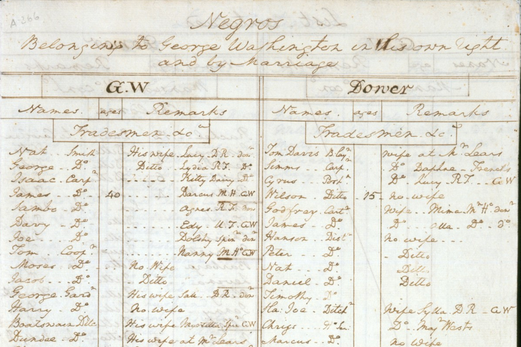by Laura Krenicki
William J. Johnston Middle School, Colchester
TEACHER'S SNAPSHOT
Town:
Statewide
Historical Background
George Washington died in 1799, and according to his will, all of his slaves were to be freed upon his death. His wife, Martha, however, had been married before, and she had slaves from her first marriage. According to the law, slave ownership passed along the male line, meaning Martha’s son from her first marriage managed the rights of those slaves. As some of the slaves intermarried, George’s “freed” slaves would not have wanted to leave their non-freed spouses or children.
D1: Potential Compelling Question
D1: POTENTIAL SUPPORTING QUESTIONS
- How were slaves treated? Were all slaves treated the same?
- What steps did some slave-owners take to protect slaves?
- George Washington visited Connecticut on more than one occasion. How might he have encountered slavery here?
D2: TOOL KIT

The first page of the slave census in George Washington’s 1799 will – Mount Vernon.
D3: INQUIRY ACTIVITY
Have students do a close-reading of the slave census. Have students investigate:
- How many different jobs can you identify on the slave census? Do these jobs appear to be farm jobs or skilled trades?
- What is the relationship between the gender of the slave and the job that he or she performed?
- Is there any evidence that children worked at Mount Vernon?
- How might the work of slaves been different in Connecticut than in Virginia, and why? Or was it different?
D4: COMMUNICATING CONCLUSIONS
Have students research slavery in Connecticut and compare it to slavery in Virginia. Are there similarities? Differences? Why do they think that is? Students should look at some original documents from Connecticut to help answer these questions. Here are two examples held in the collections of the Connecticut Museum of Culture and History: A bill of sale by Beriah Bill of Norwich, Connecticut, 1781. Bill purchased and then enlisted the slave Backus Fox in the Continental army to fulfill his share of the town’s quota for military service during the Revolutionary War. A broadside or leaflet dated 1803 announcing a reward for 18-year-old runaway slave Caesar.
Have students investigate the Witness Stones Project and reflect on the project’s purpose and the individuals remembered. For a more in-depth project, students could conduct research into their local history and propose an individual who should be recognized with a Witness Stone.
ADDITIONAL RESOURCES
Places to GO
Things To DO
Examine the slave census in George Washington’s 1799 will from the online “Biography of George Washington” by MountVernon.org.
Examine a Connecticut state census from 1782 – Library of Congress.
Websites to VISIT
Mount Vernon: Teach Slavery in Washington’s World
Articles to READ
MountVernon.org:



